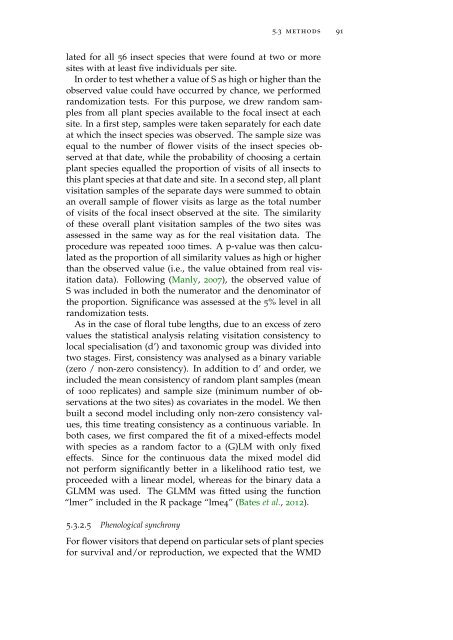Linking Specialisation and Stability of Plant ... - OPUS Würzburg
Linking Specialisation and Stability of Plant ... - OPUS Würzburg
Linking Specialisation and Stability of Plant ... - OPUS Würzburg
Create successful ePaper yourself
Turn your PDF publications into a flip-book with our unique Google optimized e-Paper software.
5.3 methods 91<br />
lated for all 56 insect species that were found at two or more<br />
sites with at least five individuals per site.<br />
In order to test whether a value <strong>of</strong> S as high or higher than the<br />
observed value could have occurred by chance, we performed<br />
r<strong>and</strong>omization tests. For this purpose, we drew r<strong>and</strong>om samples<br />
from all plant species available to the focal insect at each<br />
site. In a first step, samples were taken separately for each date<br />
at which the insect species was observed. The sample size was<br />
equal to the number <strong>of</strong> flower visits <strong>of</strong> the insect species observed<br />
at that date, while the probability <strong>of</strong> choosing a certain<br />
plant species equalled the proportion <strong>of</strong> visits <strong>of</strong> all insects to<br />
this plant species at that date <strong>and</strong> site. In a second step, all plant<br />
visitation samples <strong>of</strong> the separate days were summed to obtain<br />
an overall sample <strong>of</strong> flower visits as large as the total number<br />
<strong>of</strong> visits <strong>of</strong> the focal insect observed at the site. The similarity<br />
<strong>of</strong> these overall plant visitation samples <strong>of</strong> the two sites was<br />
assessed in the same way as for the real visitation data. The<br />
procedure was repeated 1000 times. A p-value was then calculated<br />
as the proportion <strong>of</strong> all similarity values as high or higher<br />
than the observed value (i.e., the value obtained from real visitation<br />
data). Following (Manly, 2007), the observed value <strong>of</strong><br />
S was included in both the numerator <strong>and</strong> the denominator <strong>of</strong><br />
the proportion. Significance was assessed at the 5% level in all<br />
r<strong>and</strong>omization tests.<br />
As in the case <strong>of</strong> floral tube lengths, due to an excess <strong>of</strong> zero<br />
values the statistical analysis relating visitation consistency to<br />
local specialisation (d’) <strong>and</strong> taxonomic group was divided into<br />
two stages. First, consistency was analysed as a binary variable<br />
(zero / non-zero consistency). In addition to d’ <strong>and</strong> order, we<br />
included the mean consistency <strong>of</strong> r<strong>and</strong>om plant samples (mean<br />
<strong>of</strong> 1000 replicates) <strong>and</strong> sample size (minimum number <strong>of</strong> observations<br />
at the two sites) as covariates in the model. We then<br />
built a second model including only non-zero consistency values,<br />
this time treating consistency as a continuous variable. In<br />
both cases, we first compared the fit <strong>of</strong> a mixed-effects model<br />
with species as a r<strong>and</strong>om factor to a (G)LM with only fixed<br />
effects. Since for the continuous data the mixed model did<br />
not perform significantly better in a likelihood ratio test, we<br />
proceeded with a linear model, whereas for the binary data a<br />
GLMM was used. The GLMM was fitted using the function<br />
“lmer” included in the R package “lme4” (Bates et al., 2012).<br />
5.3.2.5 Phenological synchrony<br />
For flower visitors that depend on particular sets <strong>of</strong> plant species<br />
for survival <strong>and</strong>/or reproduction, we expected that the WMD
















